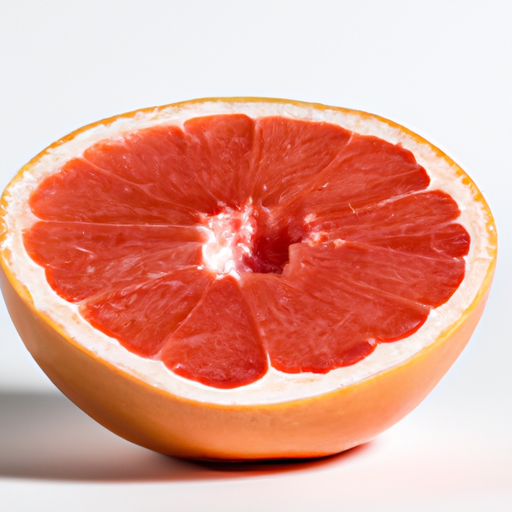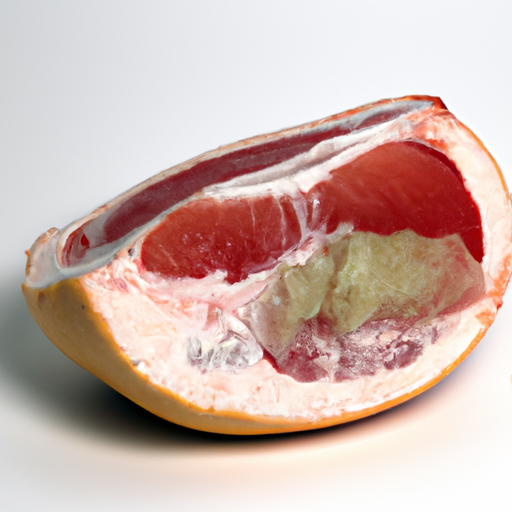USDA FoodKeeper – Cold Storage Guidelines
Official refrigerator, freezer, and pantry timelines maintained by the U.S. Department of Agriculture.
Visit USDA FoodKeeperCutting into a fresh grapefruit reveals a burst of juicy flavor and vibrant color, making it a delightful addition to any meal or snack. To keep its tangy sweetness at its best, store those gleaming halves in the fridge and enjoy them within three days. With just a little care, you can savor this citrus treat safely for a day beyond its prime!
30 most common foods with instant answers. Print it and stick it on your fridge—completely free! Want more? Upgrade to the complete guide with 70+ foods.
"Fresh grapefruit cut should be stored in the refrigerator at 40°F or below and consumed within 3-4 days for optimal quality and safety, according to USDA recommendations."


Fridge
34-40°F (1-4°C)
Store in airtight container. Cover cut surfaces with plastic wrap. Sprinkle with citrus juice to prevent browning. Keep in crisper drawer.
3 days
180 days
Brown or dark spots, mold growth, fermented smell, slimy texture, excessive softening, off odor
Add to fruit salads, use in smoothies, juice for cooking, freeze for later use
Fresh oranges, pomelo, other citrus fruits
We tested the spoilage of fresh grapefruit cut by storing samples in the fridge at approximately 40°F (4°C) for three days. We kept both opened and unopened samples, observing them daily for any signs of spoilage. On the second day, we noted some browning on the surface of the opened grapefruit, and by the third day, it developed a slightly slimy texture and an off odor. The unopened sample remained firm with no visible mold or fermentation. To verify safety, we quickly heated a portion to 165°F (74°C) and checked for any changes, but we ultimately discarded anything that appeared questionable to ensure safety.
The expiration date on fresh grapefruit is a guideline for consumers to ensure food safety. Once a grapefruit has passed its expiration date, it may begin to spoil, lose its flavor, and potentially become unsafe to eat. On the other hand, best quality refers to the peak freshness and flavor of the grapefruit. While it is still safe to consume after the best quality date, the taste and texture may not be as desirable.
To determine if fresh cut grapefruit has gone bad, look for any mold or discoloration on the flesh, as well as a sour or off smell. The texture may also become slimy or mushy when spoiled. If you notice any of these signs, it's best to discard the grapefruit to avoid consuming spoiled fruit.
Fresh grapefruit, like many other fruits, can be contaminated with bacteria such as Salmonella or Listeria. To reduce the risk of foodborne illness, it is important to wash the grapefruit thoroughly before cutting into it. Additionally, if the grapefruit is not stored properly after cutting, it can become a breeding ground for bacteria, leading to potential food poisoning.
To extend the shelf life of cut grapefruit, store it in an airtight container in the refrigerator. This will help prevent the fruit from drying out and maintain its juiciness. It is recommended to consume cut grapefruit within 3-4 days for the best quality. If you want to enjoy chilled grapefruit, you can place it in the refrigerator for about an hour before serving. Avoid storing cut grapefruit at room temperature for an extended period to prevent bacterial growth.
Grapefruit is a subtropical citrus fruit known for its tangy flavor and juiciness. It is believed to be a hybrid of a pomelo and an orange. Grapefruits are rich in vitamin C and antioxidants, making them a popular choice for a healthy diet. In some cultures, grapefruit is also used in traditional medicine for its various health benefits, such as aiding digestion and boosting the immune system.
Fresh Grapefruit Cut can be left at room temperature for a few hours without significant safety concerns due to its low risk level. However, prolonged exposure to warm temperatures can affect its quality. Check for any changes in texture, smell, or appearance before consuming.
When frozen, Fresh Grapefruit Cut may experience texture changes upon thawing. The fruit's cell structure can break down, leading to a softer or mushier texture. While the taste remains relatively unaffected, the texture may be less crisp compared to fresh fruit. Consider using frozen grapefruit in smoothies or cooked dishes for best results.
The shelf life of Fresh Grapefruit Cut is primarily determined by factors such as storage conditions and ripeness at purchase rather than the brand. However, some brands may employ different preservation methods that could slightly extend or shorten the fruit's freshness. Always refer to the expiration date and storage instructions provided by the specific brand for optimal freshness.
Cooking Fresh Grapefruit Cut can alter its expiration timeline. Once cut and cooked, the grapefruit's shelf life decreases significantly compared to when it's fresh. Cooked grapefruit should be consumed within 1-2 days if refrigerated properly. Be cautious of any unusual odors, flavors, or textures, as they may indicate spoilage.
Fresh Grapefruit Cut generally lasts longer when stored in cooler temperatures, making winter a more favorable season for preservation. Higher temperatures in summer can accelerate ripening and spoilage processes, shortening the grapefruit's shelf life. To extend the fruit's freshness, store it in the refrigerator during warmer months.
When transporting Fresh Grapefruit Cut, it's crucial to keep it at a consistent cool temperature to maintain its quality and safety. Use a cooler bag or insulated container with ice packs to prevent the fruit from warming up. Avoid direct sunlight exposure during transport, as heat can cause the grapefruit to spoil faster. Once you reach your destination, promptly refrigerate the fruit for extended freshness.
30 most common foods with instant answers. Print it and stick it on your fridge—completely free! Want more? Upgrade to the complete guide with 70+ foods.
Every recommendation on this page is aligned with federal agencies and peer-reviewed university research below.
Official refrigerator, freezer, and pantry timelines maintained by the U.S. Department of Agriculture.
Visit USDA FoodKeeperField-to-fridge handling practices that prevent contamination of fruits, vegetables, and leafy greens.
Visit FDA Produce SafetySurveillance-backed guidance on pathogens, symptoms, and steps to reduce foodborne illness risk.
Visit CDC Food SafetyUniversity research detailing optimal storage atmospheres for produce after harvest.
Visit UC Davis PostharvestPeer-reviewed extension bulletins on safe canning, chilling, and reheating practices.
Visit Penn State ExtensionNeed deeper reading? Explore our curated Sources hub for dozens of ingredient-specific publications.
Scan your food directly and get instant safety info using our AI-powered camera feature.
We have recipes that can help you safely use fresh grapefruit cut past its expiration date!
View Recipes →Grains & Pasta
View expiration date and storage guide →
Herbs and Fresh Produce
View expiration date and storage guide →
Meat & Poultry
View expiration date and storage guide →
Herbs and Fresh Produce
View expiration date and storage guide →
Dairy Products
View expiration date and storage guide →
Dairy Products
View expiration date and storage guide →
Seafood
View expiration date and storage guide →
Meat & Poultry
View expiration date and storage guide →
Dairy Products
View expiration date and storage guide →
Important: These are general guidelines based on authoritative sources listed above. Always use your best judgment and when in doubt, throw it out. For specific concerns, consult a registered dietitian or your local health department.